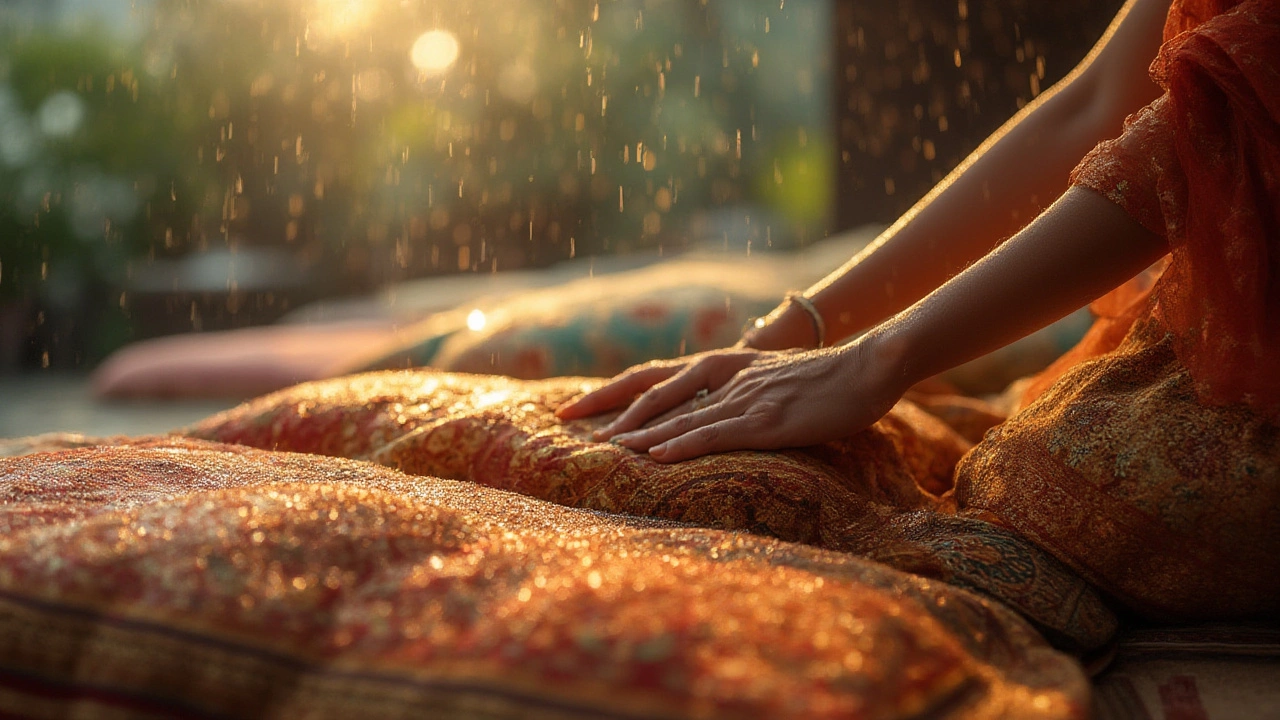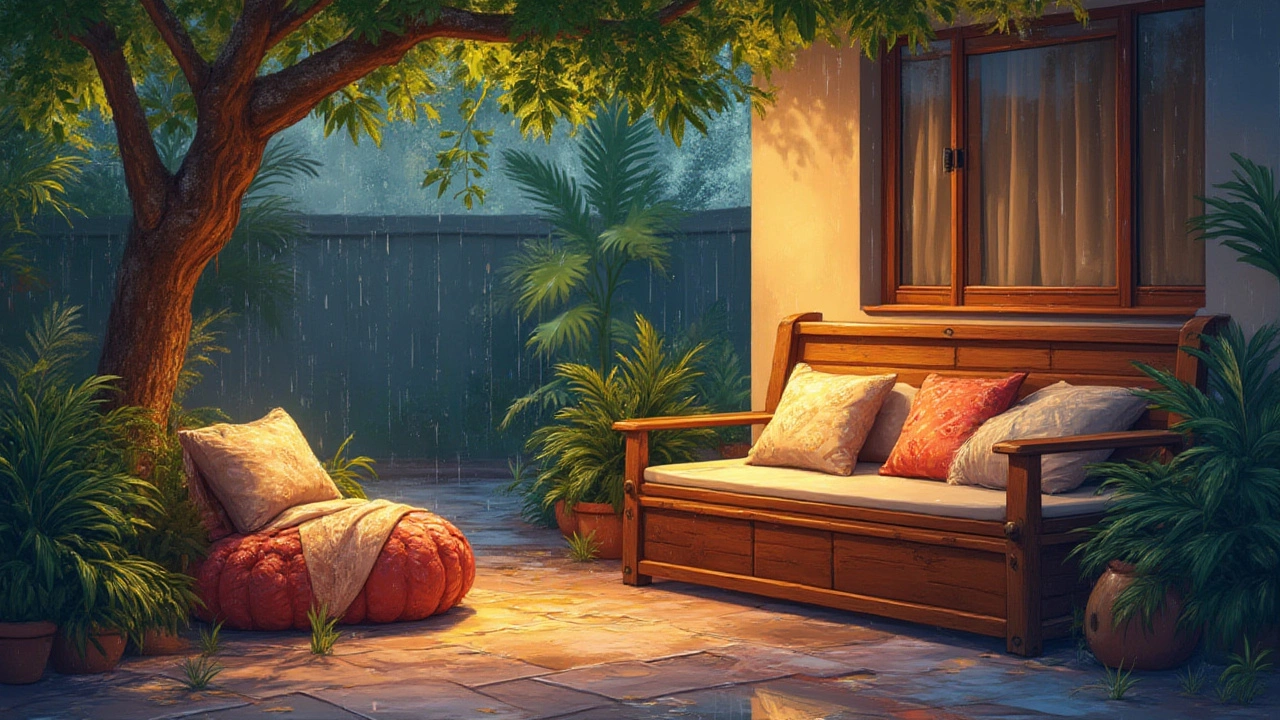You're prepping for a backyard barbecue. Burgers are sizzling, friends are laughing, and your outdoor cushions? They’re freshly fluffed and screaming summer comfort. Suddenly, the sky darkens and those first fat raindrops start to plop down. Panic. Do you grab everything and race inside? Hope the cushions are water-resistant enough to stay? Most people with any outdoor setup will deal with this headache at least once a year, if not once a week—especially if you live somewhere unpredictable, like the UK or Seattle, where even a "clear" day can turn drizzly without warning. Outdoor cushions are fabulous for comfort, but rain? Not so much. The wrong move can mean musty smells, mold, or ruined fabric—none of which you want near your guests or next barbecue.
Why Rain is Rough on Outdoor Cushions
Outdoor cushions are built tougher than your living room pillows, but rain can still do a number on them. Even cushions labeled "water-resistant" aren’t invincible. Most outdoor fabrics, like solution-dyed acrylic or polyester, are woven tightly and given special treatments to repel water. But constant soaking is a different story. Water works its way into seams, through zippers, and—unless the insert is wrapped in a waterproof liner—right down to the stuffing. Once inside, moisture takes ages to dry and encourages mold and mildew to grow. That's when you get that tell-tale sour smell or, in worst cases, a green fuzz that signals game over for your favorite seat pads.
Maybe you grew up tossing your cushions in the garage when storm clouds rolled in. Some folks have patio boxes specifically for this. Others just trust their fabric spritzed with waterproofing spray and hope for the best. Let’s get concrete: leaving outdoor cushions in the rain just makes their lifespan shorter. The Outdoor Fabrics Association did a survey showing most cushion materials, even treated ones, lose 50% of their original water-shedding ability after two seasons of use and weathering. This is especially true if you dunk them every time it rains, rather than giving them time to dry out completely between storms.
Here’s a quick look at how different fabric types handle wet weather:
| Fabric Type | Water Resistance Level | Typical Lifespan if Exposed Often |
|---|---|---|
| Solution-dyed acrylic (e.g. Sunbrella) | High, repels water well after treatment | 3-5 years |
| Polyester blends | Moderate, needs regular re-treatment | 2-4 years |
| Cotton canvas | Low, absorbs water fast | Less than 2 years |
| Olefin | High, dries quickly | 3-5 years |
Even the best outdoor cushion fabric breaks down over time, and the stuffing inside is often just regular foam. So, if you leave cushions out in the rain, you’re inviting trouble: soggy seats, quick wear and tear, and that classic mildew whiff. That's why treating rain (and the threat of rain) like a real enemy to your comfort zone keeps your outdoor hangout fresher and more welcoming. Let’s get into what you can do about it.

Smart Storage: Your Best Move When Clouds Gather
Storing outdoor cushions is a game-changer. The sooner you get them out of the rain, the longer they’ll last—and honestly, half the battle is just making easy storage part of your routine. Some folks think dragging cushions inside is a hassle. But a little planning turns this chore into a breeze.
Here are proven ways people protect their outdoor cushions:
- Deck boxes or storage benches: These are basically waterproof chests designed for outdoor use. Toss the cushions in, shut the lid, and they stay dry. If you’ve got space near your patio, these are a lifesaver. Many homeowners with garden furniture will swear by them for exactly this reason.
- Dry, ventilated sheds or garages: Got a bit of extra space in the garage? Move the cushions indoors when you see rain coming. Sheds work, too, as long as they’re watertight and you give cushions enough airflow to ward off mildew.
- Wrap in waterproof covers: There are heavy-duty, fitted covers made for everything from sofas to single seat pads. You can wrap your cushions while leaving them on the furniture. It’s not as good as full indoor storage, but shields against those short, surprise rains. Look for UV-resistant covers with taped or sealed seams for maximum protection.
- Under eaves or covered patios: Even a little overhang helps. Tuck your furniture under a roof or large umbrella if you can’t bring cushions in. This method isn’t all-powerful—wind-driven rain can still get in—but it’s way better than nothing.
If you’re the forgetful type, you can even set a weather alert on your phone. Tons of folks use apps to send a ping when there’s a storm warning. Maybe even delegate—at my place, Whiskers (my cat) is my unofficial rain alarm, as she bolts under the deck with the first drop. Don’t rely on the cat, though—set a system that works for you, and storage becomes just another easy habit.
The data backs all this up. A 2023 outdoor living trends survey by Home Innovation found that households who regularly stored their outdoor cushions during bad weather doubled their product lifespan and cut their replacement costs by up to 60%. When you factor in the price of high-quality cushions, that’s not pocket change.
One pro tip to avoid that musty, locked-in smell after storing: let the cushions dry out totally before tucking them away, especially after an evening rain. A quick wipe with a towel goes a long way. And, every so often, open the lid of your storage box or shed to let air circulate. Mold needs moisture and darkness; break that cycle, and you’ll dodge most problems.
Setting up smart storage isn’t rocket science, but it pays off big time in comfort and savings for your patio setup. Plus, there’s something great about whipping out fresh, crisp cushions on a sunny day—without a whiff of wet dog or mildew anywhere.

Quick Drying and Rescue Tactics for Wet Outdoor Cushions
So, you left the cushions out, and the heavens opened—no shame, it happens to everyone. Now what? Before you write them off as a soggy disaster, there’s a whole toolkit of drying and rescue moves you can yank out before your next garden hangout. The trick is jumping into action as soon as you can, because cushions left wet for more than a day or two get exponentially harder to salvage.
First, stand the cushions up on edge, zipper-down if possible, so gravity can help move water out. Squeeze them gently—don’t wring or twist, which can bust the seams or warp the foam. If you have removable covers, pop them off and hang both covers and the foam inserts somewhere breezy, preferably under a roof like a porch or inside a ventilated room. Even better, pop a fan nearby or aim an oscillating fan at the cushions to speed the air movement.
Direct sun is fantastic for drying, but don’t leave things out so long the fabric fades—solution-dyed acrylics like Sunbrella can hold up, but polyester or canvas can bleach in harsh sun. Alternate: an hour or two in sunshine, then move to shade. Some people prop cushions up on a mesh patio table or even laundry racks, so all sides get airflow. Flip every hour or so for maximum effect.
One trick that pros use is putting a few old towels under and on top of the wet cushion, then applying steady pressure (sometimes even sitting on them, if you trust your balance!). The towels draw out way more water than air drying alone. You can also use a wet/dry shop vac—just run it over the cushion slowly, and you’ll be surprised how much water comes out.
If the cushions still smell a little musty, it’s time for a light cleaning. Mix a solution of dish soap, lukewarm water, and a splash of vinegar. Scrub gently with a soft brush. Vinegar neutralizes mildew odors and helps disinfect. Just don’t go overboard—soaking the cushion again means you’re back to square one. Rinse with a damp cloth, blot dry, and let the sun finish the job.
Mold problems? For most mild cases—grey streaks or tiny black dots—a stronger solution using one cup of bleach to a gallon of water works for acrylic or polyester fabrics (but always spot test first, and use gloves). Scrub, rinse, dry well. If mildew returns, your insert may be the culprit—in that case, replacing just the foam insert is possible for many major brands.
Here’s a handy quick-reference list to keep your post-rain rescue on track:
- Squeeze out moisture gently, no wringing.
- Remove and air both covers and inserts, if possible.
- Use towels, fans, or vacuums to speed up drying.
- Clean with dish soap and vinegar for musty smells.
- Spot-treat mold using diluted bleach as needed.
If the forecast is for days of rain and the cushions get caught every time, they might not go moldy right away—but they’ll begin to break down faster, lose their shape, and feel less comfortable. Keeping a cycle of quick, thorough drying between storms makes cushions last, and helps them bounce back from most disasters. Once dry, treat them with a spray-on water repellant (Scotchgard or 303 Fabric Guard are popular and proven) at least once a season to boost their outdoor cushions rain resistance all over again.
At my house, rainy seasons mean running this drill more than I’d like, but it’s worth it to keep those seats fresh for summer evenings, guests, and every lazy cat nap Whiskers takes when the sun finally shows up again.

